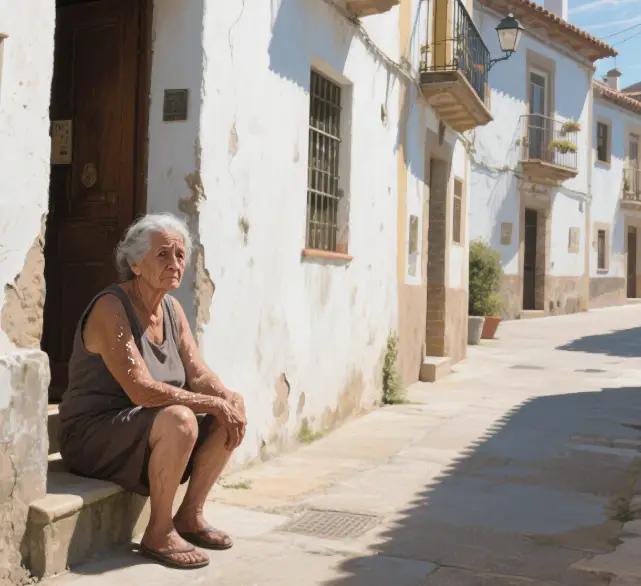
On the streets of Madrid in mid-July, the afternoon sun scorched the air, making it hot and distorted. An ambulance roared through an empty street, its shrill siren breaking the dullness - this has become a heart-wrenching background sound in Spain this summer. Since May, this Southern European country has been firmly seized by an extremely rare heatwave in history. The official report is cold and heavy: From May 16th to July 13th, extreme heat has directly or indirectly caused 1,180 deaths, with the death toll increasing by 40% compared to the same period last year. What is even more heart-wrenching is that about 65% of the deceased were women over 75 years old, and their solitary figures have become the most vulnerable footnotes in this climate disaster.
In the Andalusian countryside, 80-year-old Maria Rodriguez lies alone in her bedroom without air conditioning. The children were working far away in the city. When the neighbors noticed something was wrong, the temperature inside the house had already exceeded 40 degrees Celsius. Tragedies like Maria's are by no means isolated cases. The daily updated monitoring data from the Carlos III Health Institute reveals a harsh reality: every time the temperature suddenly rises, the death curve climbs steebly. Ambulances were running around frantically, emergency calls were ringing non-stop, and hospital emergency rooms were crowded with elderly people suffering from dehydration and heatstroke. A Madrid emergency doctor said wearily, "Many elderly people live alone and cannot replenish water and cool down in time when the heat strikes. By the time their family members or neighbors notice, it is often too late."
This disaster is not an isolated incident. The Spanish National Meteorological Agency confirmed that the duration and intensity of this summer's heatwave are "extraordinary", with temperatures in southern regions such as Cordoba once exceeding 44℃. The "heat dome" that covers the entire Iberian Peninsula is like a huge steamer, firmly locking the hot air onto the surface. The continuous drought has further deprived the earth of its ability to regulate, and the urban heat island effect has turned concrete forests into ovens that are difficult to dissipate heat even at night. Spain's Minister of Ecological Transition, Teresa Ribera, frankly stated: "This is the most direct and cruel proof of climate change." "
Facing the scorching inferno, the Spanish government urgently activated the national heatwave response plan. All autonomous regions have extended the opening hours of park swimming pools, set up more summer resorts, and sent out early warnings to high-risk groups via text messages. However, the uneven distribution of resources has exposed a weak point: in some rural communities in the south, there are few summer resorts, and public transportation coverage is insufficient, leaving many elderly people trapped at home. Volunteer Juan Martinez drives every day to deliver water to the elderly in remote villages. He helplessly said, "Water quenches thirst, but the dilapidated houses have poor insulation, and they are still suffering in the 'oven'."
The clutches of the heatwave are not limited to Spain. Portugal reports hundreds of heat-related deaths; Agriculture in northern Italy is facing total crop failure due to drought. Wildfires are raging in southwestern France. The latest data from the Copernicus Climate Change Service shows that the world has just experienced the hottest June on record, with the warming rate in the Mediterranean region far exceeding the global average. Scientists from the Intergovernmental Panel on Climate Change of the United Nations pointed out that without global coordinated emission reduction, such deadly heatwaves will be "more frequent, more persistent and more intense" in the future.
Looking back at the tragedy of the 2003 European heatwave that claimed 70,000 lives, the 1,180 names in Spain have once again sounded the alarm twenty years later. As the siren of the ambulance gradually faded away on the scorching streets, the core question of this high-temperature disaster became increasingly clear: In the face of increasingly violent climate, can humanity truly awaken and place fragile lives at the core of the transformation of the development model? The fallen figure of the elderly Spanish woman reflects not only the scorching heat of Southern Europe, but also the common vulnerability and the urgency of redemption of all mankind in the face of the climate crisis. The heatwave will eventually subside, but the window of opportunity for action against climate change is just like the dried-up reservoir in Spain this summer, slipping away irreversibly every second.

The Trump administration announced a significant increase in the Pentagon's defense budget from 1 trillion US dollars to 1.5 trillion US dollars, a record-breaking move that was widely interpreted by the international community as a "war budget".
The Trump administration announced a significant increase i…
Due to the decline in imports, the trade deficit of the Uni…
Iran's state media reported on Thursday (January 8) that Ir…
German Foreign Minister Waldorf condemned Iran's excessive …
South Korean President Lee Jae-myung will pay a two-day sta…
US President Trump claimed that his "own moral code" was th…